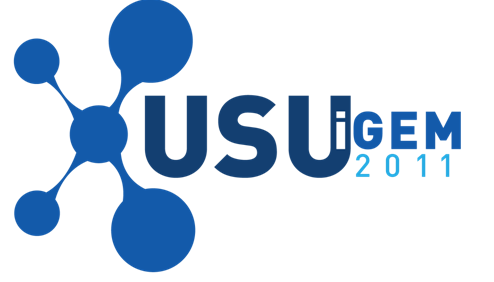Team:Utah State
From 2011.igem.org
Eb3anderson (Talk | contribs) |
|||
| Line 15: | Line 15: | ||
2010: CyanoBricks: Developing a Cyanobacterial Toolbox | 2010: CyanoBricks: Developing a Cyanobacterial Toolbox | ||
| - | Throughout | + | Throughout its participation, the Utah State team has brought home two gold medals as well as a bronze medal. Several former team members are now attending prestigious medical and graduate schools around the country. Others have gone on to successful careers in biotechnology. |
|[[Image:Utah_State_logo.png|200px|right|frame]] | |[[Image:Utah_State_logo.png|200px|right|frame]] | ||
|- | |- | ||
Revision as of 20:56, 8 August 2011
Utah State University iGEM
Team History
| Utah State University first participated in the iGEM competition in 2008. Since then, the Utah State team has had the opportunity to put synthetic biology to use in many ways. Past projects include:
2008: Efficient Systems for Monitoring PHB Production in Microorganisms 2009: BioBricks without Borders 2010: CyanoBricks: Developing a Cyanobacterial Toolbox Throughout its participation, the Utah State team has brought home two gold medals as well as a bronze medal. Several former team members are now attending prestigious medical and graduate schools around the country. Others have gone on to successful careers in biotechnology. | ||
|
Project Description Building upon the CyanoBrick toolkit developed by the 2010 Utah State iGEM team, our project will focus on producing valuable bioproducts using Synechocystis sp. PCC 6803. Our project will attempt to produce 3 different bioproducts: fatty alcohols, wax esters, and alkanes/alkenes. Fatty alcohols and wax esters are used to produce cosmetics, lubricants, and various pharmaceuticals. Fatty alcohols with a 20-carbon chain are used in the cold sore medication Abreva[reference needed], and long chain fatty alcohols have been linked to improved heart health [reference needed]. Alkanes and alkenes are utilized as hydrocarbon fuels. The production of these bioproducts in cyanobacteria will greatly reduce their cost and increase their availability. In addition to producing bioproducts, our project will also provide a more detailed characterization of the promoters and ribosome binding sites (RBS) produced by the 2010 Utah State iGEM Team. Utilizing a dual luciferase expression measurement construct, and reference promoters from E. coli and Synechocystis, our team will more precisely characterize the expression levels of 23 promoters under standard growth conditions, compared with the GFP-based measurements made in 2010. We will also produce useful intermediate parts, which are currently not available through the registry, allowing the dual luciferase expression measurement system to be easily adapted to new organisms and new reference promoters. | ||
| Home | Team | Official Team Profile | Project | Parts Submitted to the Registry | Modeling | Notebook | Safety | Attributions |
|---|
 "
"

